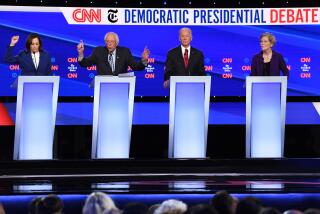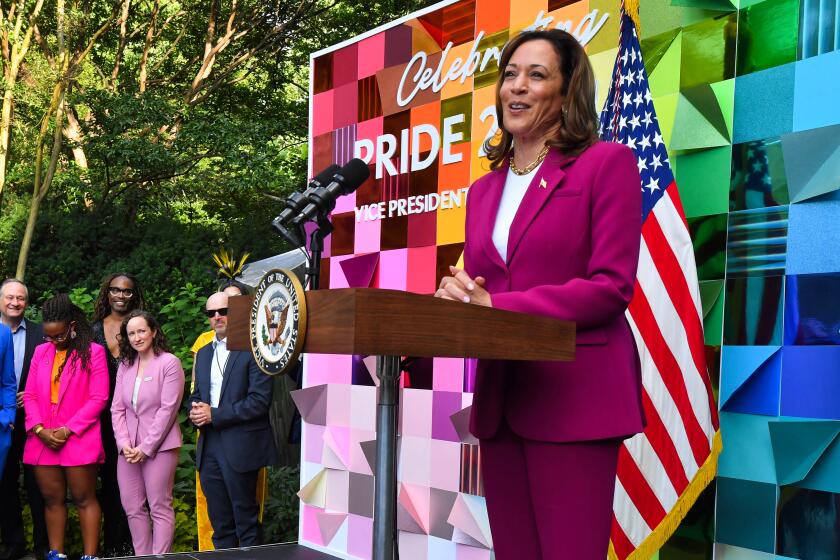New Federal Courthouse Only a Partial Solution
When the House Appropriations Committee approved funds to build a federal courthouse in Los Angeles this summer, it seemed that the long-sought facility could soon become a reality.
There was just one problem: There wasn’t enough money to build a single courthouse big enough to accommodate all the judicial activities of the sprawling Central District of California, one of the largest federal judicial districts in the nation.
So, the court will build what it can afford. Many court functions will remain in an existing building downtown.
“We’re the only major metropolitan area forced into a split operation,” said U.S. District Judge Terry J. Hatter Jr.
It has been nearly a decade since officials began planning a federal courthouse to replace the Depression-era high-rise at 312 N. Spring St. The court had outgrown the site, studies showed, and officials wanted to bring operations together in a single building, or two buildings that could be connected by a bridge or tunnel.
With budgetary and structural constraints, however, that now seems impossible.
“The amount of money from the president is sizable, it just doesn’t quite get the job done,” Hatter said.
The House Appropriations Committee allocated $314 million in July for construction of the courthouse, which will be at 1st Street and Broadway, the site of the old State Office Building. That’s in addition to $50 million previously appropriated. The federal government in 2002 purchased that building, which will be demolished.
That site is six-tenths of a mile from the Roybal Federal Building, which now is an annex to the existing federal courthouse on Spring Street, which is nearly three blocks away.
The court wanted a 1.3-million-square-foot, 54-room, 23-floor courthouse with 350 parking spaces. But that would have cost $450 million, and Congress was reluctant to spend that considering that the Roybal building opened in 1992.
The adjusted plan calls for 41 courtrooms in a 1.016-million-square-foot building that is projected to cost about $364 million. It has 150 projected parking spots.
The Spring Street courthouse has 885,000 square feet, below the size required by today’s standards. The proper size of a courthouse is determined by a formula involving the number of cases heard and the number of people represented.
From August 2003 to August 2004, there were 1,998 criminal cases filed against a total of 2,436 defendants; 14,450 civil cases were filed. More than 18 million people are represented in the Central District of California, which extends from Orange to San Luis Obispo counties.
Currently, 34 district judges and 17 magistrate judges fill the bench, with three expected to join it shortly, said U.S. District Judge William Matthew Byrne Jr.
In 1979, when Hatter was appointed to the federal court, there were 13 federal judges.
“From a building construction perspective, the [courthouse] has a lot of shortcomings as far as the security is concerned and the movement of prisoners within the courthouse,” said Mary Filippini, deputy director for the public buildings service of the General Services Administration. “A lot of security requirements have come down on the federal government as a result of Oklahoma City [the federal building bombing] and Sept. 11.
“The court just needs more space. They’re running out of courtrooms.”
When construction is completed, the magistrate and Bankruptcy Court judges will operate in the Roybal building, and the district judges will hold court in the new building, which might be completed in 2011.
A split operation presents many challenges, officials said.
Marshals, pretrial services and interpreters must be at both facilities. Jurors will travel between the two sites -- even now, they get lost between facilities two blocks apart, Byrne said -- as will lawyers, defendants, inmates and evidence.
“Clearly the court does not function as well in a split environment,” Byrne said.
Once the building is completed, the Spring Street courthouse probably will host more of the U.S. attorney’s office, Filippini said.
About 50% of the U.S. attorney’s offices are at the Spring Street location. That would come closer to 100% after the new courthouse is built. No final decision has been made.
Rep. Lucille Roybal-Allard (D-Los Angeles), who has for years worked to fund a new courthouse, said she would push for final passage of the funding bill, along with Sens. Dianne Feinstein (D-Calif.) and Barbara Boxer (D-Calif.).
“The approved design ... will be a badly needed improvement over the aging, dangerous and inefficient courthouse that exists today,” Roybal-Allard said.
Hatter, who told The Times six years ago that a new courthouse was needed “very, very badly,” sees the final plans as a mixed success.
“It’s just a real mess,” Hatter said, “and yet, it will be a new building.”
More to Read
Get the L.A. Times Politics newsletter
Deeply reported insights into legislation, politics and policy from Sacramento, Washington and beyond. In your inbox three times per week.
You may occasionally receive promotional content from the Los Angeles Times.










